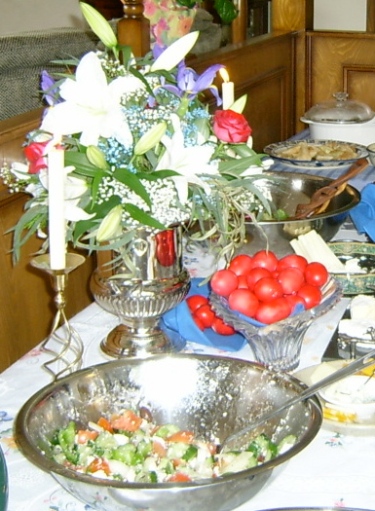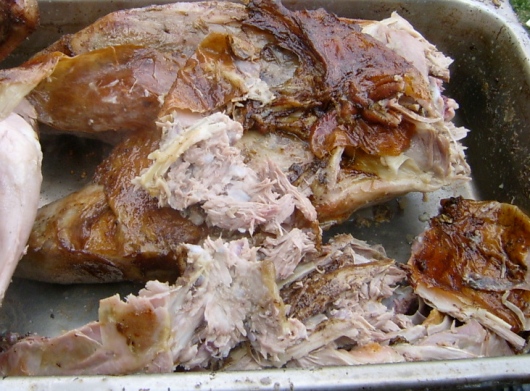Easter
Growing up in Canada with a Canadian mother and a Greek Father made for the best of both worlds during Easter. We celebrated “Canadian Easter” by painting eggs, hunting for the goodies the Easter Bunny brought and a wonderful family dinner. For Greek Easter, Orthodox Easter, (which was almost always on a different Sunday), we had a feast with lamb as the star dish. There was church too … a lot of church services during the week before Easter. The Friday before Easter was the celebration of the Epitaphio – a cloth, decorated with the image of Christ after he was removed from the cross – displayed on a bier with many, many flowers. For a complete explanation: http://en.wikipedia.org/wiki/Epitaphios_(liturgical).
The following evening, Saturday before Easter Sunday, EVERYONE went to church. This was the celebration of Christ arising from the dead and is really quite a beautiful liturgy with all the lights going out at midnight and everyone sharing the light from the one lit, blessed candle on the altar. A wave of shared light, making it’s way to everyone, even those latecomers who stood outside. As the light is passed from one to another we say “Christos Anesti”, meaning Christ has arisen, the response to this is “Alithos Anesti”, “Verily He has arisen”. Lots of chatter and happy smiles, then the procession and then FOOD!
Before anyone walks into the home, the holy light which has been kept lit (I once drove 10 K home, alone, holding a lit candle in my hand, hoping it would not go out! Silly but that’s how important this light is!) is used to draw a cross, actually blacken the underside of the top door molding, on every outside door in the home. A light meal of soup, cracking of the red eggs (and eating them, with the blessings of Christos Anesti/Alithos Anesti) – the one whose egg remained uncracked was said to be the lucky one for the year, (Greeks like to mix superstition/mythology with religion – quite fascinating really). Bedtime at 2:00 a.m. and up at 7:00 a.m. to help with the preparations for the Easter Feast.
The period of Lent was once a very strict fasting time, nothing from an animal for 40 days, with the exception of shrimp, shellfish or crab on certain days. During the last week of Lent there are days with no olive oil – can you imagine a Greek not eating olive oil? Nowadays with 9 to 5 jobs, kids in school all day, busy people with busy lives, the church has relaxed a bit and asks us to follow the Lenten restrictions during the last week, if possible. Some do, some don’t, but this was one of the reasons the Easter Feast was so important, a celebratory breaking of the fast. Butter, Cheese, Eggs, Olive Oil and of course, the sacrificial Lamb, were mandatory items for the Feast. Tsoureki is the traditional Easter Bread, Koulourakia (a mix between biscotti and shortbread), the cookie favoured by ALL children and dish after dish of delicious food. Traditionally the whole lamb is stuffed and roasted on the spit – the men’s job – but today a roast leg, chops or souvlaki would do, as long as lamb is presented, all is well.
A few photos … A recipe at the end.
 Koulourakia – not gluten free or dairy free but I will be posting the recipe on the website.
Koulourakia – not gluten free or dairy free but I will be posting the recipe on the website.
Tsoureki served with butter.
Lamb roasted on the spit. The lamb on the spit is stuffed with lemons, garlic, onions, and sometimes feta cheese. Olive Oil, Lemon, Oregano, Garlic, Pepper & Salt are used to baste the lamb, any lamb, whether it’s chops, souvlaki or roast.
 Lillies, Holy Light & Red Eggs on the table, with greek salad, chees pies, spinach pies, cheese, meatballs, potatoes, beans, roasted veggies and much more!
Lillies, Holy Light & Red Eggs on the table, with greek salad, chees pies, spinach pies, cheese, meatballs, potatoes, beans, roasted veggies and much more!
Greek Salad, Egg Salad (I make Devilled Eggs using the cracked eggs – everyone loves to crack them, it’s fun and dressed up eggs taste better than plain, hard-boiled!), Dolmadakia (Stuffed Grape Vine Leaves), Pastitsio (Greek Style Lasagna), Tiropita, Spanakopita, Meatballs, Bread, Egg & Lemon Chicken Soup or Euvarlakia (Meatball Egg & Lemon Soup), Lemon Roasted Potatoes, Cheese, Fish, Stuffed veggies (Peppers, Eggplant, Zucchini, Squash Flowers …), platters of roasted, grilled, baked vegetables. And of course, Ouzo, Wine, Retsina before, during and after the food is consumed and many, many sweets and fruits offered at the end of the meal. Truly, one rolls away from this feast, thank goodness for the dancing – traditional dancing, belly dancing – that is incorporated throughout the day!
 Red Eggs, Koulourakia, Tsatsiki, Lamb & Potatoes.
Red Eggs, Koulourakia, Tsatsiki, Lamb & Potatoes.
 Vegetarian Pastitsio (one of my daughter’s is vegetarian) with a meat patty on the side for those who would like it with meat. Pastitsio is usually made with a mixture of minced lamb & pork and sometimes just beef (hamburger). This one I made meat, dairy and gluten-free.
Vegetarian Pastitsio (one of my daughter’s is vegetarian) with a meat patty on the side for those who would like it with meat. Pastitsio is usually made with a mixture of minced lamb & pork and sometimes just beef (hamburger). This one I made meat, dairy and gluten-free.
THE RECIPE:
This dish is called Anginares me Araka (Artichoke & Peas), if you can’t find artichoke use leeks or zucchini cut into 3 cm. (1 inch) thick rounds.
Chop up tomatoes (3 small to medium sized), garlic (1-3 cloves), 1 small dry onion, 1/2 cup sliced carrots, a few small pieces of potato (1/2 cup?), 1 tsp. fennel seeds and begin frying in Olive oil over medium heat, stirring frequently. Stir in one small can tomato paste and 1/2 tsp. sugar (I use 1 tsp. honey). Add 1 cup of either artichoke hearts/leeks/zucchini (chopped in bite sized pieces/circles, pepper and salt to taste (1 tsp. & 1/2 tsp. respectively). Stir in well, add 2 cups peas, reduce heat and cover for 5 min. Sprinkle with fresh dill (1 Tbsp. or more) and mix in. Great side dish for the lamb!
Kalo Pascha to all!


